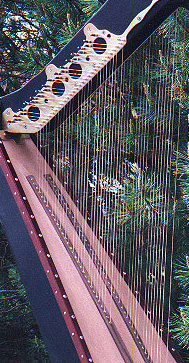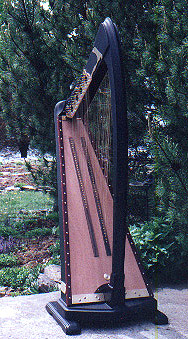














| Innovative Ideas: Some New Chromatic Harps by Philippe Clément
Note to our readers: Philippe Clement has
retired and these harps are no longer being manufactured. However, we hope
that his ideas might provide stimulation to other innovators |
|
Over the centuries, one way around these mechanisms has been to have
double or triple sets of strings, with a chromatic row parallel to one
or two diatonic rows. Another is the cross-strung harp. , with the
diatonic and chromatic rows crossing in an "X":  Sample of "X" crossing pattern I have developed harps with three more methods of dealing with chromaticism:the in-line or single row chromatic harp,the double in-line chromatic harp,and the crossing triple chromatic harp. |
|
|
In-Line Chromatic Harp For those whom the sight of a cross strung harp would make seasick, I have designed and built chromatic harps featuring all 12 strings per octave in one row. Their principle is comparable to that of the cross strung chromatic harp, except that all strings are on the same row: E, F, F#, G, G#, A, A#, B, C, C#, D, D#, E. |
 In-Line Chromatic Harp |
| I feel that this harp is simpler to play than other chromatic harps. It
has only one rank of strings, just like the diatonic harp, and strings
can be plucked without reaching above or below, which one does when
playing the cross-strung harp. However, 12 strings to the octave means
that the strings must be close together, and thus the instrument is only
suitable for fingernail plucking in a technique reminiscent of wire harp
playing. On this harp the diatonic strings are bronze wrapped, and the chromatic are nickel wrapped. All diatonic strings are equidistant, and the eye can easily spot spaces between E-F and B-C; each octave is about 4 3/8 inches wide, equal to the middle octave of a concert harp. There are 37 strings on the single row model. In-line chromatic harps may date back to the Renaissance, from which there remain oblique references to some use of 12-string octaves, so no contemporary harpmaker could call them his invention. Perhaps their time has come again. Double In-Line 37+24 Chromatic Harp |
|
 Double-line harp, detail |
 Double-line, full view |
|
This instrument is based on that
escribed above, but I have added a second parallel row of strings.
The double in-line that I build is a close relative of both the
historical double harp, like the Italian Arpa Doppia. , and the
contemporary double harp . The Arpa Doppia, however, had essentially two
or three parallel (sometimes partial) rows, one tuned to the chromatic
scale and the others to the diatonic; the contemporary double harp's
two rows are in diatonic tunings, with sharping levers on each string.
My harp's two rows, on the other hand, are permanently and identically
tuned in chromatic order.
"37+24" refers to the number of strings in each row. On the right hand row the number of strings is 24 only, in order to limit the number of strings and make the harp easier to tune. |
|
|
Crossing Triple Harp This harp is essentially a double harp (two ranks of parallel diatonic strings) with a third crossing row of chromatic strings. That is, strings of the third row are not parallel to those of the diatonic rows, as in the traditonal triple harp; instead the chromatic row intersects both the diatonic rows as on a cross strung harp, from lower left to upper right. Thus the row of chromatic strings can be reached by the right hand up under the neck of the harp, while the left hand plays them just above the soundboard. . The two diatonic rows are played as they would be on any double harp. One drawback of this harp, as is the case of other multi-course harps, is that a three octave harp boasts 60 strings, a tuning challenge indeed. |
 The crossing triple-harp |
|
Essentially, the crossing triple harp delivered what it was designed to
do: merge in one instrument the capability of two existing ones, opening
the fingerpad-plucked harp to a new dimension of musical interpretation.
The design has some limitations, however. Since only one single row of
strings provides sharps for two rows of diatonic strings, this limits
the typical abilities of the double harp (splitting or doubling the
melody, repeated notes, etc.,) if sharps are involved. In other words,
the player will only find one sharp for two naturals. This limitation of
course is not new. The traditional triple harp had only one row of
sharps for two rows of naturals, and the player had to be able to
"strategize" his-her use of the sharps. The ultimate answer to this
limitation would be a harp with four rows of strings (two naturals- two
alterations), or if one prefers: two cross-strung chromatic harps with
one single neck and one single soundboard. It can be done. The Fate of the Chromatic Harp With all their assets, one would expect that chromatic harps should, by now, have conquered the world of music. The fact that they did not has been interpreted by some critics as a demonstration of the fact that perhaps the multi-course chromatic harp was not after all the God-sent gift to harpists that it was portrayed to be. In my opinion, the marginalization of these harps had little to do with the instruments themselves and a great deal to do with the weight (or inertia) of a cultural/musical tradition. At the passing of the 20th century, harps are still very much among the most charming and the most celebrated musical instruments, the double action pedal harp is still the dominant concert harp, and multiple-course chromatic harps are still rather obscure, marginal instruments. What the 21st century will hold is very much anyone's guess. There are no signs announcing today a departure from current pedal harp or diatonic folk harp trends, as was the case at the end of the 19th century with the Pleyel cross strung chromatic harp. On the other hand, what is interesting to note, as Roslyn Rensch did in the conclusion of her book ("Harps and Harpists" 1989), is that today's harpists and builders are still dreaming of new ways of pushing the edges of their instruments. We could perhaps interpret this as: not all harpists are totally satisfied with their harp. Will the 18th and 19th century's infatuation with "machinery" which led to the double action pedal harp, finally give way to the 21st century's love of electronic gadgetry? Or will harpists of the coming generations turn themselves to more simple and pragmatic harp design solutions? In case harpists finally opt for the latter, chromatic harps will still be standing, ready to be tuned. |
|
| [To author biography] | [Back to top of page] |
Historical Harp | Folk and World Harp | Pedal Harp |
Harp Building | Harp Works | Non-Harps |
Camps & Concerts | Links | Glossary |
Donate! | Get Involved! | Contact Us | About Harp Spectrum
Copyright 2002 - 2017, Harp Spectrum All Rights Reserved